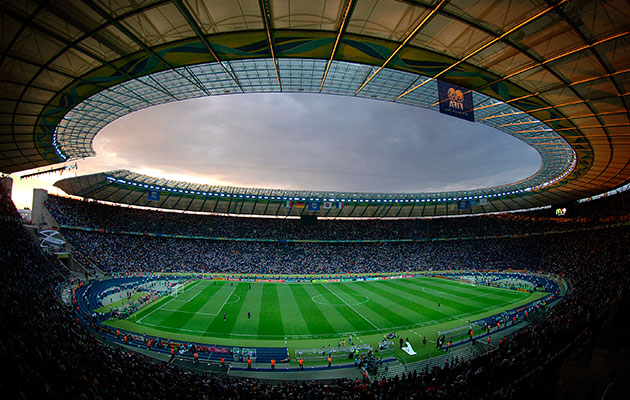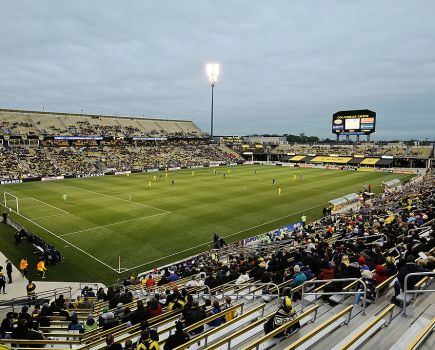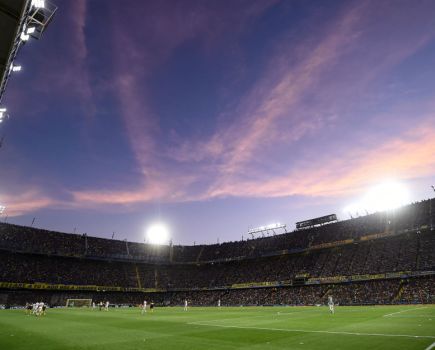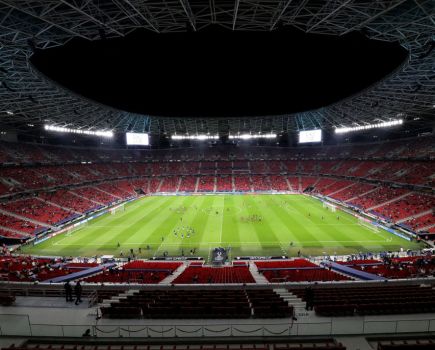Berlin is one of 200 soccer cities featured in Libero, the digital travel guide for football fans. Regularly refreshed with new destinations and features, Libero is a one-click treasure trove of football trip tips, tales and trivia. See www.liberoguide.com/berlin/.
Olympiastadion, Berlin. Germany v England, friendly. Saturday March 26/2045 CET-1945 UK time

Germany’s capital is also a football one, with a historic national stadium due to stage the Germany-England friendly this Saturday.
The regular tenants at the Olympiastadion, Hertha, may not be a Bayern or a Borussia Dortmund, but the currently high-flying Bundesliga side can still pack this 74,000-capacity landmark when playing either. This was also the stage for the 2006 World Cup Final, the place where Zinedine Zidane famously headbutted Marco Materazzi before Italy picked up a fourth World Cup.
The 1974 World Cup was also played here, but only three group games, one involving East Germany. Berlin, a paranoid, divided city before Unification in 1989, would have been the perfect setting for the GDR’s following match – in which they beat West Germany – but that took place in Hamburg.
The USSR refused to allow Berlin as a venue for Euro 88, by which time the German FA had allocated the domestic cup final to Berlin every year.
The Olympiastadion, of course, was built for Hitler’s Olympics of 1936.

Jesse Owens wins the 100m gold medal at the 1936 Olympic Games.
But a sports complex had been designed on this site for another Games 20 years before. 1916 was cancelled because of World War I, and architect Otto March died before the stadium was put to full use. It later staged four German championship finals, one featuring Union and one featuring Hertha, as well as Germany’s first post-WWI international in 1920. Long-distance legend Paavo Nurmi set a world record here in 1926.
It was left to his sons Werner and Walter to create anew when Berlin was re-awarded hosting rights in 1931. Within two years, Hitler was in power and a revised plan was set in stone – natural stone, 30,000 cubic metres of it, transported from all over the nation to symbolise Germanic values. A titanic 110,000-capacity bowl centrepieced a complex of smaller stadia, a 25,000-capacity amphitheatre and the ceremonial Maifeld, where Mussolini addressed nearly one million Germans in 1937.
A Bell Tower and clock towers provided the final touch to a grandiose creation that would serve as a stage for black athlete Jesse Owens to rain on Adolf’s parade.
The stadium – though not the bell, cracked right through its swastika emblem – pretty much survived the war and the Maifeld was used by Allied forces for sports events. Invited to join the inaugural Bundesliga in 1963, Hertha moved in, floodlights were installed and West Germany played the occasional international here.
A roof was added when it came to host the 1974 World Cup, but by then Hertha had fallen from grace, and the arena was a bit a of a white elephant and historic embarrassment. Capacity was 76,000.

Hertha’s revival, kick-started by a gala Reunification match against Union in January 1990, prefaced reconstruction for the 2006 World Cup. The Marathon Gate with its clock tower remained in place for the reconstruction, which lowered the pitch, extended the roof and upgraded the lighting. Spectators, now closer to the pitch, could number 74,500, all agog as Zinedine Zidane headbutted Marco Materazzi in the final.
Having regained Bundesliga status in 2014, Hertha attracted a 50,000-plus average attendance in 2014-15. Their most faithful following gather in the Ostkurve of this two-tier arena, sectors Q-T – though in reality, all the stadium but guest sectors G and H by the Marathontor wave blue-and-white flags on league days. The now low curve of seating throughout means an optimum view wherever you are, in the Süd Haupttribüne, Gegentribüne opposite or either Kurve.
On the ground
The Olympiastadion has two stations. The one on the red U2 line, eight stops from Zoo, gives access to the main walkway lined with souvenir stalls and grills. You’ll need to follow the signposts through pre-war underpasses. The station on the S5 S-Bahn, six stops from Zoo, is far closer to the arena, the hub of bars on Coubertinplatz and the visitors’ sectors. If you’re changing at Westkreuz, platform 1 serves the Spandau branch of the S5 line.
Ticket offices are found at either main gate you come to from the U- or S-Bahn stations, and Hertha have several other outlets in town.

There are a modest number of stadium souvenirs on offer at the Besucherzentrum at the Osttor (nearest the U-Bahn station and Olympischer Platz), open on non-match days daily from 9am-7/8pm mid-March to late October, 10am-4pm daily November-mid March.
On match days, souvenir vans line Olympischer Platz and stalls and marquees dot the entrance to the Ostkurve.
Basic tours (€7/€5 children), allowing access to the Bell Tower, can also be taken with a 60-minute, eight-stop, English-language audio guide (€3). German-language guided tours (€10/€8; 11am, 1pm & 3pm, plus 5pm summer, 11am only winter) last 60-75mins, with bookable English-language ones on many weekends. These are not available on match days or the morning. Slightly dearer ‘Premium’ Tours (Sun) with an architectural bent, and Hertha-focused ones (Thur) are also available, again bookable in English.

Those arriving by U-Bahn will be immediately faced with two brick huts: to the left, “Zur Blau-Weißen Legende”, covered in well executed Hertha murals; to the right, Berlineya Sektoya, in faux Russian script. Both are basic stand-up kiosks offering €2 rostbratwurst and Berliner Kindl beer.
Diagonally opposite the S-Bahn station stands the Preußisches Landwirtshaus, an authentic Prussian bar/restaurant with grill terrace and sunken room indoors with a vast TV screen. Berliner Eisbein (ham hock) and potato soup with bockwurst are typical dishes. A short walk nearer the stadium, the Stadionterrassen offers a simpler menu in a more stripped-down interior that displays pre-war photos of the stadium in construction. Bitburger and Schneider Weiße on draught make a welcome change from Kindl. It’s in the main building of the Berlin Sports Association that also features a lesser-known bar on its roof terrace facing the Olympiastadion.

Opposite is the most characterful option, Schultheiss Am Olympia-Stadion, ‘Since 1983’, with little touches of classic Hertha and Berlin iconography in a cosy, two-room interior. By another S-Bahn exit, on the corner of Trakehner Allee and Gutsmuthsweg, the Wurstmaxx Biergarten purveys Berlin’s famous currywurst, sausage in curry sauce.
Inside the stadium, beer is 3% proof Carlsberg – don’t forget the deposit on the glasses.







